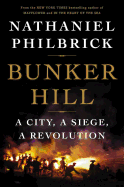
In most accounts of the American Revolution, the "shot heard round the world" at Lexington on April 19, 1775, marks the beginning of the war. But the fierce battle at Bunker Hill two months later elevated a few skirmishes between the redcoats and the ragtag colonial forces to all-out combat. Nathaniel Philbrick's Bunker Hill is a fascinating, detailed account of the occupation and siege of Boston, the mustering of the patriot army and the battle that would change the fortunes of the city--and the American colonies.
Philbrick (Mayflower; In the Heart of the Sea) covers familiar events such as the Boston Tea Party and the confrontation at Lexington, but reframes them in the context of a city where an occupying army confronted a restless, divided citizenry, taking into account the decided lack of organization among the town militias of Massachusetts. Although well-known patriots such as Samuel Adams and George Washington appear, Philbrick focuses on Dr. Joseph Warren, leader of the patriot movement. He also introduces lesser-known figures in both the patriot and loyalist camps, exploring the links between the two sides and the complicated relationship of the colonies to the Crown.
The tension builds as Philbrick approaches the battle itself, mapping out the precarious positions of both armies and explaining the significance of both Bunker Hill and the later fight on Dorchester Heights. Vividly told and full of well-drawn personalities, Bunker Hill provides fresh insight into the bloody beginnings of the American fight for independence. --Katie Noah Gibson, blogger at Cakes, Tea and Dreams

